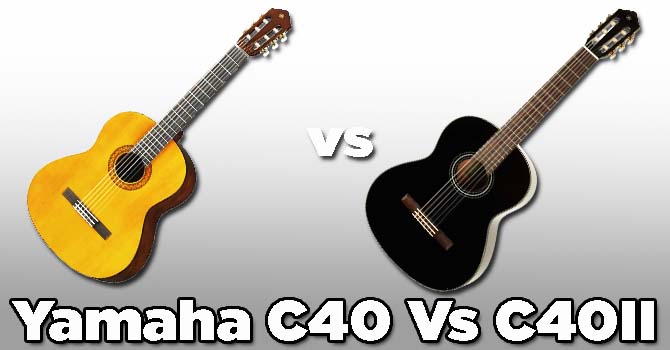Yamaha C40 Vs C40II [Difference & Which is Better Performing]
Yamaha produces the world’s most popular & well-crafted classical guitars. The Yahama C40 and C40II models are of them. The C40 and C40II are classical guitars designed for beginners. Both of these guitars offer great sound and playability. So it seems too hard to decide which one is the better-performing.
These two models have some important differences in materials, design, and performance—their features & construction qualities, their performance characteristics, and their sound system. Take a look at the Yamaha C40 vs C40II models quality. Included details information that will help to understand the differences. The details comparison is to decide which model is better.

# Table of Contents =>
Comparison Table:
| Features – | Yamaha C40 | Yamaha C40II |
| Top Wood | Spruce | Spruce |
| Fretboard & Bridge | Rosewood | Rosewood |
| Neck Wood | Nato | Nato |
| Sides/Ribs/Back | Meranti | Meranti |
| Body Depth | 3.7 – 3.94″ | 3.7 – 3.94″ (94 – 100 mm) |
| Finish | Gloss | Gloss |
| Number of Frets | 18 | 19 |
| Color of Product | Black Wood | Brown / Yellow |
| Pattern | Fire/Sunburst, Single-coloured, Wood | Single-colored, Wood |
Details About Yamaha C40 Guitar:

The Yamaha C40 is an ideal classical guitar for beginners & experienced players. Its slim neck profile makes it comfortable for players with smaller hands.
With its spruce top, nato back and sides, and rosewood fingerboard, the C40 produces a warm, full-bodied tone. It is perfect for both fingerstyle and strumming. It offers plenty of sustain with a bright tone.
The action is set low, and the strings easily press down. Making it ideal for beginners & experienced players who want to play classical music. It is affordable and highly durable.
Things We Liked / Pros:
- Its excellent craftsmanship, construction, and design are of high quality.
- Its tone is also great, with a bright, sweet sound that is perfect for various styles.
- A cutaway body style that provides access to the higher frets.
- It also comes with a built-in pickup and preamp.
- Low-string action makes it easy to play, and a lightweight body that is comfortable to hold.
Things We Didn’t Like / Cons:
- The C40’s neck may be too wide, and the action may be too high
- The laminated spruce top on the C40 can be prone to warping
- The pickguard may also come loose over time
- The tuning machines are not as smooth as those found on higher-end guitars
- The C40 has a non-adjustable truss rod
- The guitar has a limited range of tones
Details About Yamaha C40II Guitar:

The Yamaha C40II is a high-quality classical and the best guitar for practice with performance. The combination of quality materials and craftsmanship makes the C40II the perfect choice.
Its body is constructed with spruce and nato wood and features a rosewood fretboard. It is strung with nylon strings, offering a balanced, warm tone ideal for classical pieces.
The smooth satin finish ensures a comfortable playing experience. The low action allows for precise and effortless fingerpicking. While the adjustable truss rod allows for precise neck adjustment. Its beautiful sound, reliable construction, and comfortable playability are perfect for classical guitar.
Things We Liked / Pros:
- Excellent choice for both beginners and experienced guitar Users
- Classic dreadnought body, spruce top, and rosewood fingerboard with the bridge
- The acoustic tone is perfect for fingerpicking
- The guitar is lightweight and comfortable to hold
- The C40II has an onboard preamp and tuner
Things We Didn’t Like / Cons:
- The C40II does not have a cutaway body which makes it difficult to reach the higher frets
- The neck is quite wide, which may be uncomfortable for smaller hands
- C40II is not as loud as other classical guitars
- The tone of the strings can be a little muddy
Main Difference Between Yamaha C40 Vs C40II:
1) Sound Quality:

The C40 has a more focused, warm tone, which is great for playing classical music. The C40II has a more powerful, brighter sound, which is great for playing a wider range of music. The C40II has a slightly more & brighter sound due to the matte finish on the top and the improved bracing. Allows the C40II to produce a more resonant and articulate sound than the C40.
C40 has a slightly warmer tone that makes a suited to playing classical music. The Yamaha C40 & C40II classical guitars offer similar sound quality. The C40II provides a clearer and more balanced sound. This is due to the improved bracing & the matte finish on the guitar’s top.
2) Tuning stability:
The Yamaha C40 and C40II are both classical guitars, but their tuning stability is a major difference. The C40 features a traditional headstock design with geared tuning machines, while the C40II features a slotted headstock with advanced tuning machines. Yamaha C40 utilizes a precision diecast body and tuning machines with a stable & consistent gear ratio. Which provides reliable tuning stability.
The upgraded tuners on the C40II provide improved tuning stability, allowing the strings to stay in tune longer. The slotted headstock design on the C40II reduces the tension on the strings, resulting in less stress on the neck and reducing the risk of neck warping. C40 also includes a diecast chrome-plated tuning key designed to hold the tuning more securely and provide maximum tuning stability.
3) Design:

The Yamaha C40 and C40II are two classical guitars that share many similarities. Their design qualities differ significantly. The C40 has a matte finish, making it durable & resistant to scratches. The C40II has a glossy finish, giving it a more refined and polished look.
The C40II also has higher-end features such as a solid spruce top, a rosewood fingerboard, and a mahogany back and sides. The C40 has a nato fretboard, while the C40II has a rosewood fretboard, which provides a smoother feel and better intonation.
C40II has a more comfortable neck shape, allowing for easier playability. The C40II also has a more stable neck joint than the C40, which helps to create better sustain. C40II has a higher-quality preamp and pickup system and a modernized bridge design providing a more balanced and vibrant sound.
4) Pickup:
The C40 features a piezo pickup that produces a natural sound. It offers a greater dynamic range than traditional magnetic pickups. The C40 pickup has a 6-pole design. It helps to reduce hum and feedback when playing at higher volumes. Keeping the instrument in tune is also easier with the C40 pickup’s built-in tuner.
The C40II has a larger pickup, which offers a fuller sound and more sensitivity. It also has a three-band tone control, allowing for more control over the sound. The C40II also has more advanced preamp circuitry, producing more accurate sound reproduction.
5) Price:
The Yamaha C40 is more affordable, with a retail price of around $150. The Yamaha C40II is slightly more expensive, with a retail price of around $180. The extra price for the C40II is due to its improved quality and construction. It also has a solid spruce top, rosewood back and sides, and a slightly slimmer body. But the price difference between the two should be taken into consideration when making a purchasing decision.
So, Which should I choose?
When it comes to making a choice between the Yamaha C40 vs C40II, it is important to consider your individual needs as a musician. You can also look at the difference. The C40 has a spruce top and Nato sides and back, while the C40II has a spruce top and meranti sides and back.
The C40II also has a slightly thinner neck than the C40, making it a great choice for those with smaller hands. The C40II has an improved preamp system that offers greater tonal control. The C40 is ideal for beginners because it offers a thicker neck and lower string action, making it easier to play.
The decision of which one to choose comes down to personal preference, but how you plan to use them will be the most important factor.
What I Look on About The Yamaha C40 and C40II?
Yamaha C40 and C40II can make great beginner guitars for individuals wanting to learn how to play. For someone just starting out, the C40 is an ideal guitar. The C40II is a great option for those who want to advance their performance.
FAQs:
Question 1: What is the difference between Yamaha C40 and C45?
Answer: The Yamaha C40 and C45 are classical guitars with similar features and designs. The C45 is slightly larger than the C40. That is a full-size body and a slightly heavier weight. The C45 has a slightly longer scale length, affecting the strings’ tension.
Question 2: Is Yamaha C40 good for fingerstyle?
Answer: It is a fantastic choice for fingerstyle musicians. The slim neck profile offers excellent playability. While the full-size body provides a full, rounded sound. The instrument is also relatively lightweight, making it comfortable to play for extended periods. It is equipped with a spruce top & body, giving it a balanced tone that can easily be adapted to different musical genres.
Question 3: Does Yamaha C40 have nylon strings?
Answer: The strings of the Yamaha C40 are made of a nylon composite material. Which is a combination of nylon and other materials. This type of string provides a mellow sound with a wide dynamic range.
The strings are also highly resistant to wear and tear. It makes them more durable & less prone to breakage. The Yamaha C40 is easier on the fingers than traditional steel strings. Yamaha C40 does indeed have nylon strings.
Question 4: Is Yamaha C40 solid or laminate?
Answer: It is a classical guitar that is constructed from solid wood. It is a classical guitar constructed with a laminated spruce top and Meranti back and sides. The laminate construction contributes to its durability, allowing it to withstand the wear and tear that comes with regular use.
Last Updated on February 3, 2023 by Perry Garner


